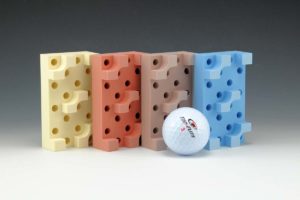Plastic Machining
In order to machine plastics, whether commodity or advanced engineering plastics, it is of paramount importance that engineers, designers, and machinists understand the following:
- The properties of the material to be machined.
- What machining processes can be used, or are available.
- The capabilities/limits of the processes available.
When trying to machine complex geometries and hold tight tolerances, plastics are far less forgiving than ferrous metals or non-ferrous metals.
Everything is relative; for example, holding a flatness tolerance of .0003″ on a surface that is 1″ in diameter is far different than holding the same tolerance on a surface that is 12″ in diameter. Holding an overall length tolerance of .001″ on a 12″ long piece of nylon is far different than holding that tolerance on a 12″ long piece of PEEK. (Nylon, under high humidity or water submergence, can absorb -by weight – 7% water, thus resulting in up to 2% dimensional changes.)
Many machine shops claim tolerance capabilities, but tolerance claims mean absolutely nothing without explaining the variables involved. A good example of an overly simplified claim is a statement such as: “flatness capabilities of .0003 inch”. Mica-Tron Products Corp. does not state machining tolerance capabilities because there are far too many variables involved to make such statements meaningful. Instead, we look at every machining requirement individually. Our capabilities are supported by the fact that our workforce includes degreed Mechanical Engineers who have considerable materials science background, and machinists who have decades of experience machining non-metallics.
Every request for quotation that Mica-Tron Products Corp. receives is carefully reviewed to ensure that the desired end result can be achieved.
This process includes answering questions such as:
- Is the specified material available in the size required?
- Is the material readily available?
- Can the material meet the dimensional requirements specified?
- Can the geometry of the part be machined?
- Are there features which could be achieved more easily if the geometry is slightly modified?
- Is custom tooling required or can standard tooling be used?
- Are custom fixtures required to achieve the geometry?
- Are there special testing services required?
- What are the quality notes?
- What are the risks involved?
Risk analysis involves looking at all the possible things that can go wrong including: material delivery issues or sole source material problems, critical equipment failure, required hardware or custom tooling delivery problems.
…Essentially, we analyze risk in order to minimize risk.
Once we have reviewed a customer’s quotation request, we determine if the quote can be submitted as issued or if we need to contact the customer and discuss problems that we’ve discovered during our quoting process.
Since 1959, Mica-Tron Products Corp. has been machining plastics, composites, machinable ceramics, and foams. Our facilities are “state of the art” and our experience and knowledge speaks for itself.
We look forward to meeting your machining requirements!


